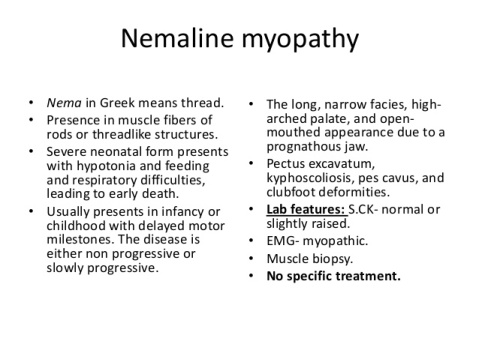Nemaline myopathy

Etiology:
A rare genetic muscle disorder. Six different clinical subtypes of nemaline myopathy have been identified based on disease severity and age of onset, ranging from a severe congenital-onset (at birth) form that is usually lethal in the first few months of life, through to less severe forms with onset in childhood or adulthood.
It is defined by muscle weakness and the presence of fine, thread-like or rod-like structures called “nemaline bodies”, when muscle biopsies are viewed under the microscope. The prefix “nema-” is derived from Greek and means “thread-like.” Nemaline bodies consist of accumulations of muscle proteins due to mutations in genes which encode proteins components of the muscle thin filament.
Signs & Symptoms:
- muscle weakness
- diminished muscle tone (hypotonia)
- reduced or absent reflexes.
- Muscle weakness is usually most severe in muscles of the face, neck and proximal muscles. (The proximal muscles are the muscles that are closest to the center of the body such as the muscles of the shoulder, pelvis, and upper arms and legs.)
- In most people, muscle weakness is static (nonprogressive) over time.
- Weakness of the muscles of breathing and swallowing are the major cause of morbidity and mortality.
Clinical presentation:
- affected individuals may develop distinctive facial features including an elongated face, a displaced jaw that is farther back than normal (retrognathia), and a highly-arched roof of the mouth (palate).
- Muscle weakness may also cause difficulty speaking (dysarthria) and swallowing resulting in feeding difficulties.
- Some infants with nemaline myopathy may require a feeding tube.
- may develop abnormally fixed joints that occur when thickening and shortening of tissue such as muscle fibers cause deformity and restrict the movement of an affected area (contractures),
- a sunken chest (pectus excavatum),
- abnormal side-to-side-curvature of the spine (scoliosis) or abnormal rigidity of the spine.

Severe Congenital (Neonatal) Nemaline Myopathy
- This form of nemaline myopathy is apparent at birth and accounts for approximately 16 percent of cases.
- Affected infants have profound muscle weakness and severe hypotonia.
- Infants with this form of nemaline myopathy experience difficulty sucking and swallowing leading to feeding difficulties,
- show little spontaneous movement,
- exhibit respiratory insufficiency.
- Some infants may experience the passage or backflow (reflux) of the contents of the stomach or small intestines into the esophagus (gastroesophageal reflux).
Intermediate Congenital Nemaline Myopathy
- This form of nemaline myopathy is less severe than the severe congenital form and more severe than the typical congenital form.
- It accounts for approximately 20 percent of cases.
- The early development of contractures is characteristic of this form of nemaline myopathy.
- As affected infants age, they often experience delays in attaining motor milestones or may not be able to sit up or walk independently.
- Children with intermediate congenital nemaline myopathy often require a wheelchair or ongoing breathing (ventilatory) support during childhhood.
Childhood-Onset Nemaline Myopathy
- This form of nemaline myopathy usually becomes apparent between 10-20 years of age and accounts for approximately 13 percent of cases.
- The development of early motor skills is usually unaffected.
- Sometime during the late teens or early twenties, affected individuals develop slowly progressive muscle weakness.
- Affected individuals may be unable to bend the foot upward toward the leg (foot drop).
- Eventually the entire ankle and lower legs muscles are involved. In one family with this form of nemaline myopathy, two members required wheelchairs by age 40.
Adult-Onset Nemaline Myopathy
- The onset and severity of this form of nemaline myopathy varies.
- It is extremely rare accounting for only 4 percent of cases.
- It occurs in individuals between the ages of 20-50 who develop generalized muscle weakness that may progress rapidly.
- Muscle pain (myalgia) may also occur.
- Involvement of certain neck muscles may make it difficult to hold one’s head up and cause the head to drop.
- Although uncommon, some individuals may develop respiratory or cardiac complications often in conjunction with increasing muscle weakness. This form of nemaline myopathy may be distinct form the genetic or inherited forms of the disorder.

Amish Nemaline Myopathy
- This form of myopathy was identified in several related families within an Amish community.
- Onset is shortly after birth and affected infants may have hypotonia, multiple contractures, and tremors, which usually diminish over the first few months of life.
- Affected infants have progressive muscle weakness, a severely deformed chest with a prominent sternum (pectus carinatum), muscle wasting (atrophy) and life-threatening respiratory insufficiency.
- Severe neonatal respiratory disease and the presence of arthrogryposis multiplex congenita (joint contractures, which are permanent shortening of a muscle) often lead to death in the second year of life.

Genetics:
- Ten genes have been found to cause nemaline myopathy. Nemaline myopathy can be inherited as an autosomal recessive or dominant trait.
- At least 50% of cases of nemaline myopathy follow autosomal recessive inheritance, and the remainder are inherited in an autosomal dominant manner or are sporadic (new dominant cases – the first occurrence in the family).
Diagnosis:
- based upon a thorough clinical evaluation, a detailed patient and family history and identification of characteristic findings.
- confirmed by the presence of thread- or rod-like structures (nemaline bodies) on muscle biopsy when stained with Gomori trichrome.
- A biopsy is the surgical removal and microscopic evaluation of affected tissue. Increasingly the diagnosis is made or confirmed by molecular genetic testing for mutations in the genes known to cause nemaline myopathy.
Treatment:
- No specific treatment exists for nemaline myopathy.
- Treatment is supportive and directed toward the specific symptoms that are apparent in each individual.
Source: https://rarediseases.org/rare-diseases/nemaline-myopathy/
